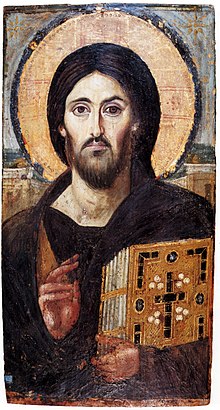Description and production
With a height of 84 cm, width of 45.5 cm, and a thickness of 1.2 cm, the icon was originally taller and wider before its top and sides were cut. [14] Otherwise, there is only one spot with major damage, a large portion of Christ's hair on his left side, including his left ear and shoulder. [14] The original encaustic surface has continually been preserved in excellent condition overall. [14]
As with many of the early icons from Sinai, the Christ Pantocrator was created by using the technique, known as encaustic—a medium using hot wax paint—that was rarely used in the Byzantine world after the iconoclastic controversies of the eighth and ninth centuries. [15] The monastery at Sinai is the only place in the world where a substantial number of encaustic icons, particularly those dating from as early as the sixth century, have been preserved. [16] During the period of Byzantine Iconoclasm, the production of Orthodox icons continued at Sinai, whereas they were being destroyed in Constantinople. [17]

Saint Catherine's Monastery, officially the Sacred Autonomous Royal Monastery of Saint Catherine of the Holy and God-Trodden Mount Sinai, is a Christian monastery located in the Sinai Peninsula of Egypt. Located at the foot of Mount Sinai, it was built between 548 and 565, and is the world's oldest continuously inhabited Christian monastery.

Daphni or Dafni is an eleventh-century Byzantine monastery eleven kilometers northwest of central Athens in the suburb of Chaidari, south of Athinon Avenue (GR-8A). It is situated near the forest of the same name, on the Sacred Way that led to Eleusis. The forest covers about 18 km2 (7 sq mi), and surrounds a laurel grove. "Daphni" is the modern Greek name that means "laurel grove", derived from Daphneion (Lauretum).
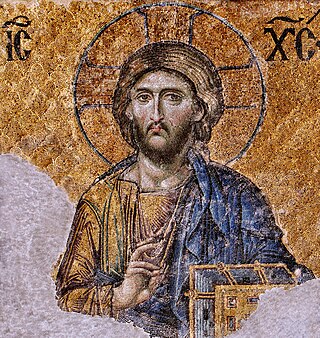
Byzantine art comprises the body of artistic products of the Eastern Roman Empire, as well as the nations and states that inherited culturally from the empire. Though the empire itself emerged from the decline of western Rome and lasted until the Fall of Constantinople in 1453, the start date of the Byzantine period is rather clearer in art history than in political history, if still imprecise. Many Eastern Orthodox states in Eastern Europe, as well as to some degree the Islamic states of the eastern Mediterranean, preserved many aspects of the empire's culture and art for centuries afterward.

In Christian iconography, Christ Pantocrator is a specific depiction of Christ. Pantocrator or Pantokrator, literally ruler of all, but usually translated as "Almighty" or "all-powerful", is derived from one of many names of God in Judaism.
Kurt Weitzmann was a German turned American art historian who was a leading figure in the study of Late Antique and Byzantine art in particular.
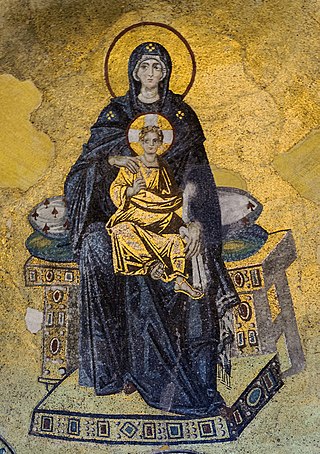
Macedonian Renaissance is a historiographical term used for the blossoming of Byzantine culture in the 9th–11th centuries, under the eponymous Macedonian dynasty (867–1056), following the upheavals and transformations of the 7th–8th centuries, also known as the "Byzantine Dark Ages". The period is also known as the era of Byzantine encyclopedism, because of the attempts to systematically organize and codify knowledge, exemplified by the works of the scholar-emperor Constantine VII Porphyrogennetos.

Hosios Loukas is a historic walled monastery situated near the town of Distomo, in Boeotia, Greece. Founded in the mid-10th century, the monastery is one of the most important monuments of Middle Byzantine architecture and art, and has been listed on UNESCO's World Heritage Sites since 1990, along with the monasteries of Nea Moni and Daphnion.
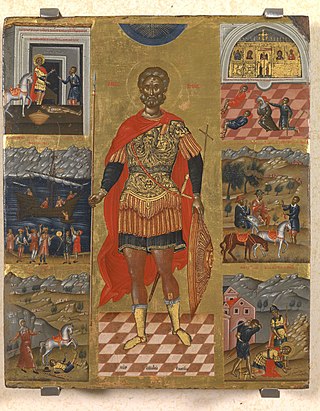
Cretan School describes an important school of icon painting, under the umbrella of post-Byzantine art, which flourished while Crete was under Venetian rule during the Late Middle Ages, reaching its climax after the Fall of Constantinople, becoming the central force in Greek painting during the 15th, 16th and 17th centuries. The Cretan artists developed a particular style of painting under the influence of both Eastern and Western artistic traditions and movements; the most famous product of the school, El Greco, was the most successful of the many artists who tried to build a career in Western Europe, and also the one who left the Byzantine style farthest behind him in his later career.
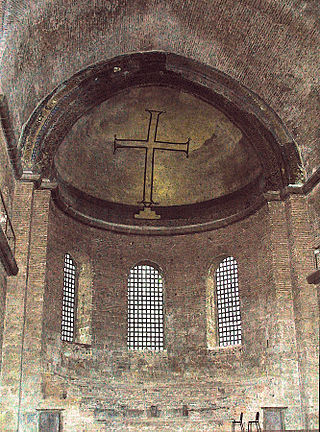
The Byzantine Iconoclasm were two periods in the history of the Byzantine Empire when the use of religious images or icons was opposed by religious and imperial authorities within the Ecumenical Patriarchate and the temporal imperial hierarchy. The First Iconoclasm, as it is sometimes called, occurred between about 726 and 787, while the Second Iconoclasm occurred between 814 and 842. According to the traditional view, Byzantine Iconoclasm was started by a ban on religious images promulgated by the Byzantine Emperor Leo III the Isaurian, and continued under his successors. It was accompanied by widespread destruction of religious images and persecution of supporters of the veneration of images. The Papacy remained firmly in support of the use of religious images throughout the period, and the whole episode widened the growing divergence between the Byzantine and Carolingian traditions in what was still a unified European Church, as well as facilitating the reduction or removal of Byzantine political control over parts of the Italian Peninsula.

A Hodegetria, or Virgin Hodegetria, is an iconographic depiction of the Theotokos holding the Child Jesus at her side while pointing to him as the source of salvation for humankind. The Virgin's head usually inclines towards the child, who raises his hand in a blessing gesture. Metals are often used to draw attention to young Christ, reflecting light and shining in a way to embody divinity. In the Western Church this type of icon is sometimes called Our Lady of the Way.
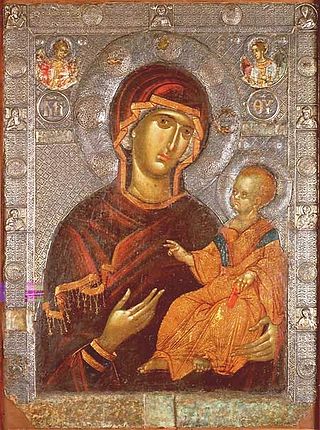
The Palaeologan Renaissance or Palaiologan Renaissance is the final period in the development of Byzantine art. Coinciding with the reign of the Palaiologoi, the last dynasty to rule the Byzantine Empire (1261–1453), it was an attempt to restore Byzantine self-confidence and cultural prestige after the empire had endured a long period of foreign occupation. The legacy of this era is observable both in Greek culture after the empire's fall and in the Italian Renaissance. Scholars of the time utilized several classical texts.

The Twelve Apostles are a common subject in Christian art and serve as a devotional tool for many Christian denominations. They were instrumental in teaching the gospel of Jesus, "continuing the mission of Jesus" with their depictions continuing to serve as spiritual inspiration and authority. Many Protestant denominations reject religious imagery, including the veneration of the apostles and other religious figures.

The Church of Sinai is a Greek Orthodox autonomous church whose territory consists of St. Catherine's Monastery at the foot of Mount Sinai in Egypt, along with several dependencies. There is a dispute as to whether the church is fully autocephalous or merely autonomous. The church is headed by the Archbishop of Mount Sinai and Raithu, who is traditionally consecrated by the Greek Orthodox Patriarch of Jerusalem and also serves as abbot for the monastery. The current hierarch is Archbishop Damian.

The Icon of the Annunciation in St. Catherine's Monastery in Sinai, Egypt is an unusual Byzantine icon attributed to the late twelfth century. The Annunciation icon is an example of the late Komnenian-era style and was likely produced in Constantinople. The icon, tempera on wood, is one of the largest icons on display at St. Catherine's Monastery, at 61 cm high and 42.2 cm wide. Very similar Annunciation icons exist to help establish the date of the Sinai icon. One at Kurbinovo in North Macedonia, dated 1191, and the icon at Lagoudhere on Cyprus, dated 1192. The icon has distinctive elements that lead art historians, such as Evans and Wixom, to suggest the icon may have been produced at St. Catherine's Monastery itself rather than Constantinople. The Annunciation icon shares features found exclusively on other icons only at the Sinai monastery, such as the reflective circles scored in the surface of the gold and the grisaille medallion with the infant Christ on the Virgin Mary's breast.
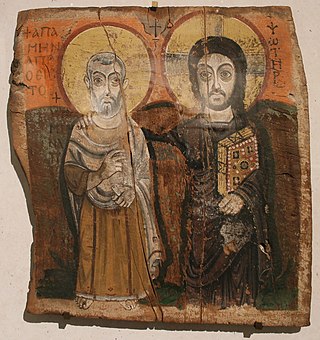
The Icon of Christ and Abbot Mena a Coptic painting which is now in the Louvre museum, in Paris. The icon is an encaustic painting on wood and was brought from the Apollo monastery in Bawit, Egypt. The icon measures about 57 by 57 centimetres and is 2 centimetres thick. The icon has been damaged over the years with some of the pigment missing and it has two vertical cracks running through the image, but it can still be readily made out.

Ieremias Palladas, also known as PouladasIeremia Pallada. He was a Greek Renaissance painter. He was a clergyman, painter, and educator. He was affiliated with Saint Catherine's Monastery in Mount Sinai, Egypt. He is one of the most notable Greek painters of the 17th century. His family consisted of clergy and painters. His nephew was Patriarch of Alexandria Gerasimos Palladas. His work was influenced by Nikolaos Tzafouris and Angelos Akotantos. Georgios Klontzas and Emmanuel Lambardos were active in Crete around the same period. Palladas influenced the works of Theocharis Silvestros, Iakovos Moskos, Ioannis Kornaros and Philotheos Skoufos. According to the Institute of Neohellenic Research, twenty-four of his works survived. His specialty was painting crosses for the iconostasis or templo. Most of his works are in Egypt.

Euphrosynos was a Greek Renaissance painter. He was a priest and influenced by Byzantine art and the early Cretan School. Five of his works have survived, all of them are in Greece. His technique resembled the works of Andreas Pavias, Angelos Akotantos, and Andreas Ritzos. Euphrosynos may have been a member of the prominent Klontzas family. His paintings of the Virgin Mary and Jesus are typical Cretan School paintings. His Jesus painting resembles Pavias's painting Christ Pantocrator. All of his works are at Mount Athos in the Dionysiou Monastery. They decorate the iconostasis. Fragkos Katelanos and Theophanes the Cretan were also working at Mount Athos around the same period.

The Virgin of the Burning Bush was a painting made of egg tempera and gold leaf on a wood panel. The portable icon was signed by Greek painter Michael Damaskinos. Damaskinos has over 100 known works. He was a distinguished member of the Cretan school of painting. He was from Crete. His contemporaries included Georgios Klontzas and El Greco. Damaskinos spent over twenty years traveling all over Italy. He spent a significant time in Venice. He adopted Italian artistic mannerisms which he applied to his paintings.

Christ Pantocrator is a tempera painting created by Ieremias Palladas. Ieremias was associated with Saint Catherine's sacred monastery in Egypt also known as Mount Sinai. He was a Sinaitic monk, painter, and teacher. His nephew Gerasimos Palladas became the Patriarch of Alexandria. There was a dependency of Saint Catherine's Monastery which was in Mount Sinai, Egypt on the island of Crete which was called Saint Catherine's Monastery of Heraklion. The site in Egypt was believed by Christians to be the site where Moses saw the burning bush. The Patriarch of Jerusalem Nectarius wrote about the painter in his archives because Ieremias was one of the most influential figures of his time.
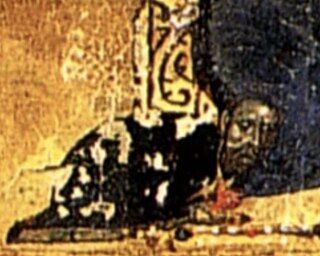
John Tohabi was a Georgian ordained priest, hieromonachos and icon painter whose works were donated in the High Middle Ages to the Saint Catherine's Monastery on Mount Sinai and its monastic community, originally all displayed together for the decoration of the entire church.
